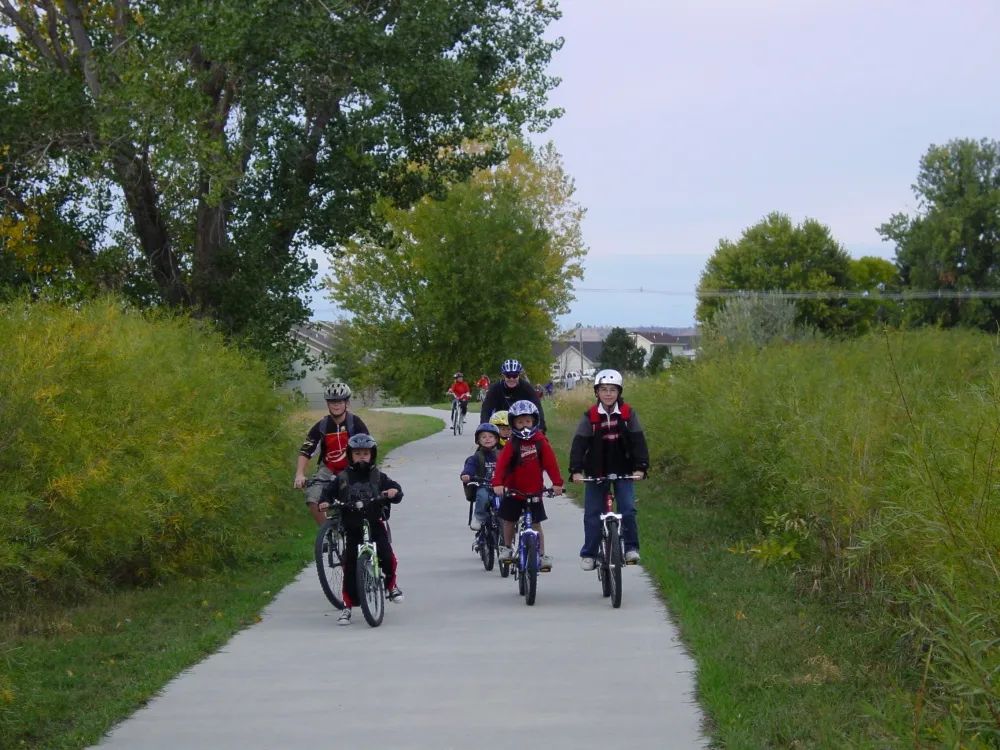
Wide Open Spaces: Connectivity
February 2022
by anna rogers | photos courtesy of Billings TrailNet
“Find a path or make one.” - Lucius Annaeus Seneca
There is a network that is the lifeblood of our community – spidering out along the Yellowstone, up to the Rims, across the Heights, and reaching to the West End. This network has cultural and historic roots, enables recreation and conservation, and spurs economic growth. It is the connector of the parks and open spaces, linking our community to the outdoors. The network is Billings’ trail system.
What We’ve Got
Have you walked your kids to school, biked the Zimmerman Back 9, or taken a run along the Jim Dutcher Trail? Have you gazed upon the Yellowstone from Norm's Island or thrown a disc at Phipps? Paved and unpaved, flat and steep, urban and secluded – our trails make the wide open spaces accessible.
Billings has 50 miles of trails with plans for more to come. These trails connect residents to parks, parks to other parks, people to schools and businesses, and people to points of interest. They make walking, biking, and other forms of active transportation safe and possible.
The system is robust, offering opportunities to explore urban parks, walk along the river, and even get up above the city for a bird’s eye view. The trails belong to the people – most are maintained by the city or county, with a few exceptions. “We are trying to enable people to be out in the open and in nature – whether groomed parkland or wild,” says Kristi Drake, Executive Director of Billings TrailNet, an organization that raises money for paved trails.
But in 2012, federal money for funding trails was discontinued. “We need people to be educated and understand that there is no funding for trails,” Drake explains. The city has been collaborating financially with Billings TrailNet and applying for grants where they can. Still, there's just no funding for trails like the Stagecoach Trail that would connect the valley to the rims. Drake hopes that people in Billings will continue to take a vested interest in trails and bring more support to the table, noticing where trails are lacking and making their voices heard.
Why It Matters
“Think about it. When was the last time you met a grouchy bike rider?” Steve Sherman wrote in his 1974 book titled Bike Hiking. Over 45 years later, not much has changed. Access to trails for walking, biking, running, scooting, hiking, and rolling indicates a community's vitality and vibrancy.
Trail connect us to history and culture beyond the obvious benefits of recreational use. They link us to the past, unite us in the present, and write a better story for our futures. Studies like the Trails for All Americans report have found that “trails contribute to economic vitality, increased property values and increases in regional tourism.”
As our last Wide Open Spaces article discussed in the January 2022 issue, providing communities with better access to the outdoors is linked to improving mental health issues, and trails are the tools to provide this access. Trail usage also affects physical health and fitness. For example, researchers studying the effects of a recreational trail system on BMI published findings in 2019 that children within 0.5 miles of trails had a reduced risk of obesity (Move More, Gain Less: Effect of a Recreational Trail System on Childhood BMI).
The benefits of trails are endless, and one outcome that is woven throughout the story of Billings is how trails are bringing people and organizations together.
Who’s Making It Happen?
One of the most beautiful aspects of the local trails’ connectivity is the way they are uniting people. The current system, constant planning, and dreams for the future result from collaboration among many organizations and individuals. Follow the trail of Billings' history, and you can trace many hands, dollars, sweat, and hours etched into what we now enjoy. Their work made possible the post-Thanksgiving walks with family, little ones’ first bike rides, and high plains vistas.
To name a few heavy hitters, Billings TrailNet works to raise money, and the city and county work to obtain grants, build, and maintain. Other organizations, like Yellowstone River Parks Association (YRPA), who celebrated their 30th birthday last year, have been involved in building trails through volunteer and community efforts. In addition, the Chamber of Commerce hosts a quarterly trail meeting that brings groups with different interests but similar goals together to scheme and dream a more connected Billings.
Looking to the future, it’s US who make trails happen – you and me. “The most important thing is for people to see a vision,” Drake says. “Envision our city with trails that are right outside back doors, getting people better access to trails, and bringing trails into areas that are lacking.”
Trails enrich communities, stimulate economies, attract talent, increase home values, improve health and fitness habits, protect resources, and keep people connected to the land and those around them. What could be better for sustaining connectivity in our city?
Want to get connected (in more ways than one)? Check out the following organizations, who are all constantly collaborating to keep Billings connected through trails:
- Big Sky Economic Development
- Billings Bicycle Pedestrian Advisory Committee
- Billings Chamber of Commerce
- Billings Parks & Rec
- Billings TrailNet
- Bureau of Land Management
- City of Billings
- Downtown Billings Alliance
- Healthy By Design
- Montana Department of Transportation
- Our Montana Inc.
- Pedal United
- The Spoke Shop
- Yellowstone County
- Yellowstone Rim Runners
- Yellowstone River Parks Association (YRPA)
Helpful Tools for Connecting to Billings’ Trails & Parks:
- Traillink.com
- Billings Heritage Trails App
- Explore Yellowstone River App
- Go Play! Trail Map at BillingsTrailNet.org/Trails/
Originally printed in the February 2022 issue of Simply Local Magazine
Never miss an issue, check out SLM's digital editions here!





